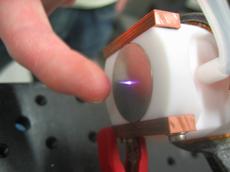Pesticides are in for it now
ETH Zurich chemists have developed a method to detect pesticide residues in foodstuffs – a method that may also be of interest for other areas and may enable quality checks on a running basis.

When customers stand in front of a fruit and vegetables shelf in a supermarket, they have their last chance to decide whether to buy standard Granny Smith apples or rather the Gala variety from an organic orchard?
If they decide in favour of Granny Smiths grown non-organically, they run the risk of ingesting harmful poisons together with valuable vitamins when they eat them. To combat pest organisms, fruit and vegetables are sprayed with plant protection agents, less euphemistically called pesticides. As a consequence, pesticide residues remain in the foods and are eaten by consumers in their diet. Renato Zenobi, Professor of Analytical Chemistry at the Laboratory of Organic Chemistry and his doctoral student Matthias Jecklin have now developed a mass spectrometric method enabling pesticide residues in foodstuffs to be detected quickly.
Mass spectrometer analyses toxic substances
A year ago the group presented a method based on mass spectrometry that enables the surfaces of objects of any kind to be analysed (cf. the ETH Life article of 7.9.2007). The new method to determine pesticides also uses what is known as a quadrupole time-of-flight mass spectrometer (QTOF-MS), but how do the chemical compounds get into the mass spectrometer?
Normally the pesticides in samples of fruit and vegetables need to be extracted before they can be analysed in a mass spectrometer. To avoid this time-consuming process, Jecklin built an atmospheric pressure glow-discharge source (APGD source), an electric source which generates a plasma, i.e. an ionised gas, at atmospheric pressure. When aimed at a piece of fruit peel, the plasma stream detaches molecules from the surface of the peel. These are then transferred directly into the mass spectrometer where the ions can be fragmented using a collision gas, thus enabling the researchers to identify the chemical substances in a fruit.
The method has many applications
Zenobi admits that, “Although this method can determine chemical compounds faster and more straightforwardly, the method is not yet a suitable way to quantify the amounts identified.” He says that, currently, the method can be used for preliminary probing – if pesticide residues are found in fruit and vegetables, conventional methods can be used to quantify how much of the substances has been discovered.
Nevertheless, the method for determining pesticide residues in fruit and vegetables is very promising. Zenobi and Jecklin have in mind quality checks on a running basis: various foodstuff samples that are analysed on a moving belt by the mass spectrometer. Zenobi says the method is also attractive for forensic and medical purposes. For example traces of drugs or explosives on surfaces could be detected, or human sweat and breath analysed – which could help to diagnose an illness quickly.







READER COMMENTS